jamesp
Cave Dweller 
Member since October 2012
Posts: 36,607
|
Post by jamesp on Apr 17, 2015 6:27:36 GMT -5
Poured some slurry off about a week ago and let it sit to see if it would harden after settling. What you see is about an inch of clean water, and the clay settling under it also about an inch thick. Still getting great course grind rates with the clay in the rotary. Great instant protection for labra, granite, rose quartz and amazonite, no frosted edges. Been looking for a slurry that works good with felspars. Medium to fairly thick slurry does not impede grind rate; it distributes the grit immediately. 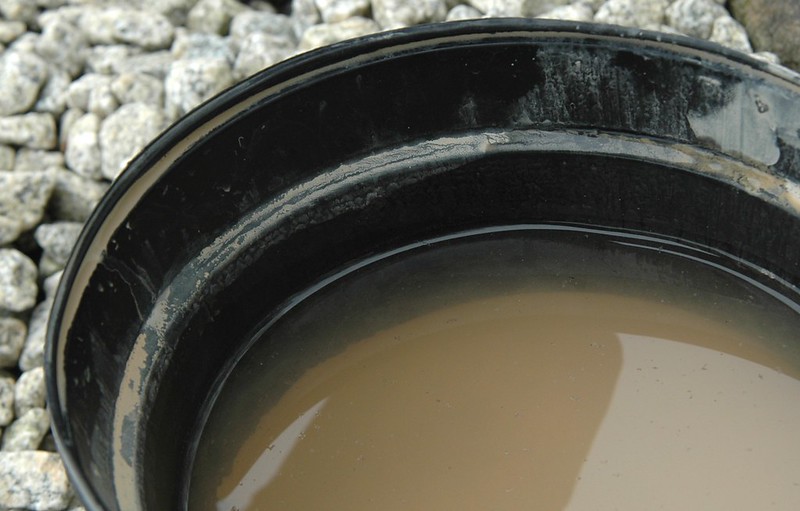 Upon pouring it out there is little concretion at the bottom of the pail. You can see the clay slurry level about an inch up the wall of the pail. Clay slurry stays suspended for a long time. Would remix easily after a long stoppage of the barrels. 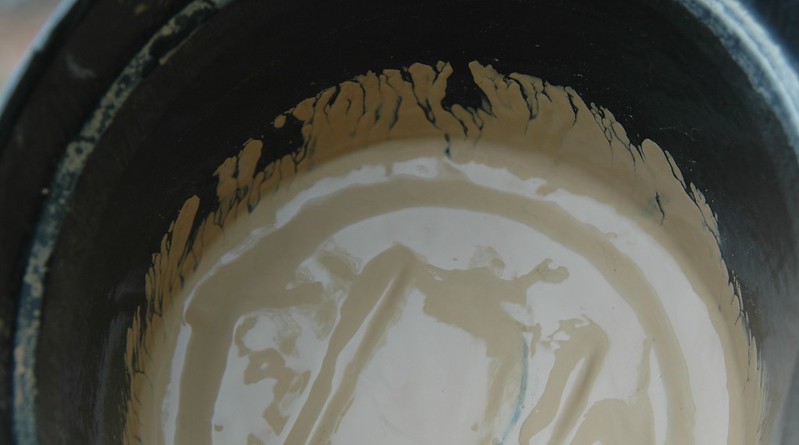 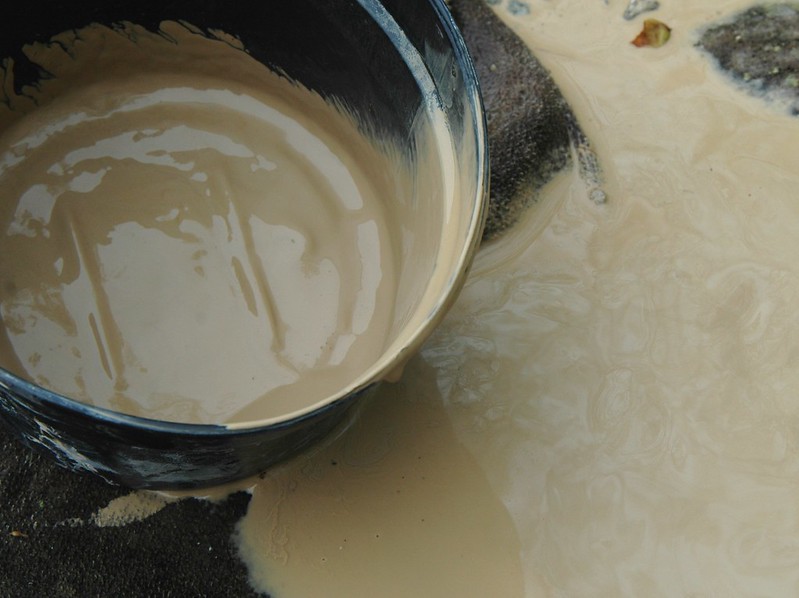 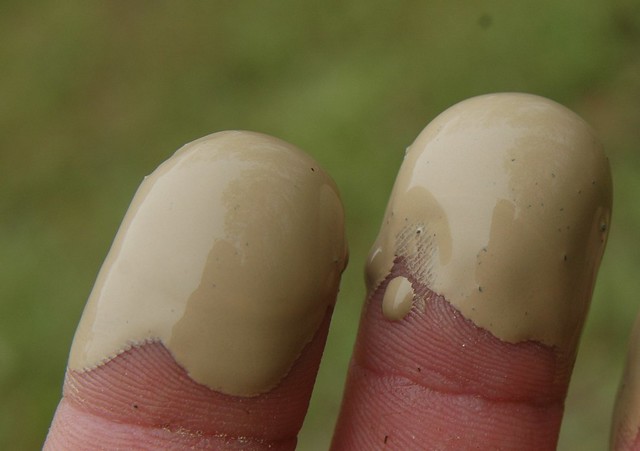 |
|
jamesp
Cave Dweller 
Member since October 2012
Posts: 36,607
|
Post by jamesp on Apr 17, 2015 6:54:29 GMT -5
Will be looking for hill top clay deposit to collect from. Such deposits are virtually free of sand and perhaps usable for a slurry in pre-polish and polish. And very pasty. Not sure how clay was deposited, but many hills in this area are clay because it erodes slower than sandier soils. cccalhoun.com/products/baseball-mound-clay/ 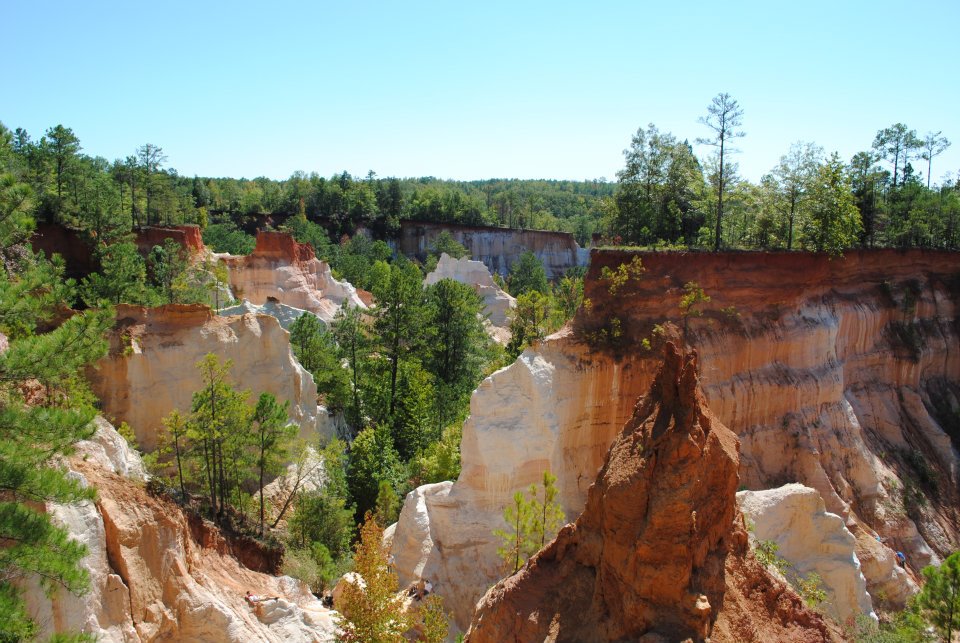 |
|
megalotis
starting to spend too much on rocks
 
Member since April 2009
Posts: 226 
|
Post by megalotis on Apr 17, 2015 9:29:48 GMT -5
Okay, I'll play dumb. Okay, I AM dumb. Why don't you want sand in your clay? Unless you're working softer material, then I would understand.
Your clay experiment is very cool! The results seem to be all positive, so far!
|
|
megalotis
starting to spend too much on rocks
 
Member since April 2009
Posts: 226 
|
Post by megalotis on Apr 17, 2015 9:32:11 GMT -5
Beautiful pictures, by the way. Reminds me a little of Bryce Canyon in Utah. Who says erosion can't be pretty?
|
|
jamesp
Cave Dweller 
Member since October 2012
Posts: 36,607
|
Post by jamesp on Apr 17, 2015 12:49:33 GMT -5
Okay, I'll play dumb. Okay, I AM dumb. Why don't you want sand in your clay? Unless you're working softer material, then I would understand. Your clay experiment is very cool! The results seem to be all positive, so far! Naw, not dumb. Answer is not so obvious. Clay particles very small and in this case flat.But heavy. In this case the slurry was set for a week and it took a long time to settle. Meaning that the clay stayed suspended in the water. Which makes the water/slurry mix heavy. Which helps 'float' the grit. Helping the grit to circulate with the rocks for cutting them. Good grit mixing instantly with instant slurry. Sand may scratch the rocks in 1000 and polish stage. Acting as grit particles. Clay particles are really small, and may/may not slow polish, not sure yet. |
|
jamesp
Cave Dweller 
Member since October 2012
Posts: 36,607
|
Post by jamesp on Apr 17, 2015 12:51:38 GMT -5
Beautiful pictures, by the way. Reminds me a little of Bryce Canyon in Utah. Who says erosion can't be pretty? Yes, erosion can be a cool landscape. such as Bryce Canyon, or in the above photos Providence Canyon in south Georgia. |
|
megalotis
starting to spend too much on rocks
 
Member since April 2009
Posts: 226 
|
Post by megalotis on Apr 17, 2015 14:49:24 GMT -5
I gotcha. I guess I would have assumed that sand, being softer than agate, would just work like tiny "smalls", but couldn't scratch the agate? It makes sense that it could scratch softer stones, though...
|
|
jamesp
Cave Dweller 
Member since October 2012
Posts: 36,607
|
Post by jamesp on Apr 17, 2015 18:46:30 GMT -5
I gotcha. I guess I would have assumed that sand, being softer than agate, would just work like tiny "smalls", but couldn't scratch the agate? It makes sense that it could scratch softer stones, though... I will find out soon enough megalotis. Georgia has lots of garnet in it's soils. They may present a problem. And a lot of the clay has aluminum oxide. So I am not sure what to expect at polish level. Check out kaolinite or china clay. |
|
|
|
Post by gingerkid on Apr 17, 2015 19:02:07 GMT -5
jamesp, have you visited the Lil Grand Canyon?
|
|
jamesp
Cave Dweller 
Member since October 2012
Posts: 36,607
|
Post by jamesp on Apr 17, 2015 19:38:09 GMT -5
jamesp, have you visited the Lil Grand Canyon? Providence Canyon ? Yep. but the kaolin mines in Huber GA(out I-16) were probably more bizarre with all the different colors of clay. They used to let you romp around in the kaolin mines, they may have closed them due to the bluffs. |
|
jamesp
Cave Dweller 
Member since October 2012
Posts: 36,607
|
Post by jamesp on Apr 18, 2015 15:02:11 GMT -5
Behind the house. a rich clay vein 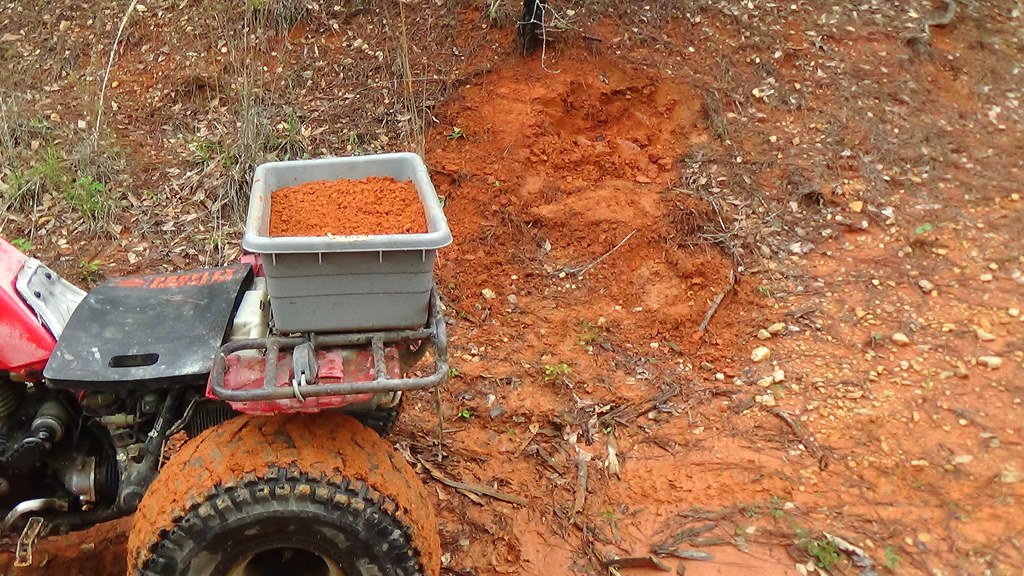 |
|
|
|
Post by rockpickerforever on Apr 18, 2015 18:05:40 GMT -5
That is some red-@ss clay, jamesp! That must be what Frankie is talking about when he says he is still playing in the red GA clay, lol.
Ya know, James, you could probably go to a ceramics store in Hotlanta (bet they have at least one there  ) and pick up a 20 lb slab of white clay. Generally pretty sand free, already wet, and totally homogenized. The best shtuff is slicker than lizard snot! Even better, none of that red dye #57. But you'd have to pay for it. $25 for 50 lbs, not too bad. This is at an online store - link They also have porcelain clay, and if you must have it, also red clay. ) and pick up a 20 lb slab of white clay. Generally pretty sand free, already wet, and totally homogenized. The best shtuff is slicker than lizard snot! Even better, none of that red dye #57. But you'd have to pay for it. $25 for 50 lbs, not too bad. This is at an online store - link They also have porcelain clay, and if you must have it, also red clay.
There's also an Atlanta Clay company, only 33 cents a lb when you buy it by the ton. |
|
jamesp
Cave Dweller 
Member since October 2012
Posts: 36,607
|
Post by jamesp on Apr 18, 2015 18:47:23 GMT -5
That is some red-@ss clay, jamesp! That must be what Frankie is talking about when he says he is still playing in the red GA clay, lol.
Ya know, James, you could probably go to a ceramics store in Hotlanta (bet they have at least one there  ) and pick up a 20 lb slab of white clay. Generally pretty sand free, already wet, and totally homogenized. The best shtuff is slicker than lizard snot! Even better, none of that red dye #57. But you'd have to pay for it. $25 for 50 lbs, not too bad. This is at an online store - link They also have porcelain clay, and if you must have it, also red clay. ) and pick up a 20 lb slab of white clay. Generally pretty sand free, already wet, and totally homogenized. The best shtuff is slicker than lizard snot! Even better, none of that red dye #57. But you'd have to pay for it. $25 for 50 lbs, not too bad. This is at an online store - link They also have porcelain clay, and if you must have it, also red clay.
There's also an Atlanta Clay company, only 33 cents a lb when you buy it by the ton. i need to wet it, add a few agates and tumble just to make a nice clay paste for a body suit. Or have a mass clay soaking pit and charge hotties to come bath in it. or would that be the other way around... |
|
jamesp
Cave Dweller 
Member since October 2012
Posts: 36,607
|
Post by jamesp on Apr 19, 2015 6:10:32 GMT -5
That is some red-@ss clay, jamesp! That must be what Frankie is talking about when he says he is still playing in the red GA clay, lol.
Ya know, James, you could probably go to a ceramics store in Hotlanta (bet they have at least one there  ) and pick up a 20 lb slab of white clay. Generally pretty sand free, already wet, and totally homogenized. The best shtuff is slicker than lizard snot! Even better, none of that red dye #57. But you'd have to pay for it. $25 for 50 lbs, not too bad. This is at an online store - link They also have porcelain clay, and if you must have it, also red clay. ) and pick up a 20 lb slab of white clay. Generally pretty sand free, already wet, and totally homogenized. The best shtuff is slicker than lizard snot! Even better, none of that red dye #57. But you'd have to pay for it. $25 for 50 lbs, not too bad. This is at an online store - link They also have porcelain clay, and if you must have it, also red clay.
There's also an Atlanta Clay company, only 33 cents a lb when you buy it by the ton. Was reading about potter's clay Jean. They add about 10% silica sand to the clay for firing and mechanical reasons. So, I probably have clay like the red above that has little silica for tumbling. Trying to avoid the silica for polishing slurry. Some of it deposited as suspended particulates with little sand, like river banks and ancient deposits that cover parts of Georgia and about every other state. Fortunately Georgia is rich in kaolinite type clay since we are granite capitol. It is mostly eroded felspar and composed of flat platelets. Great clay. Going to visit Atlanta Clay Company. Never knew it existed, and about 2 miles from where I grew up. I had brought in some Florida (gumbo)clay to amend the sand at my camp so I could grow aquatic plants there. it was 3 dump truck loads, about 50 tons. He dumped it in my shallow pond. It was chunky and hard. I noticed when the chunks sat in water over night they turned to flat piles of wet clay, as if they dissolved. So i put a sprinkler head on each pile. After two days the piles went from being 4 feet tall and 10 feet around, to like 8 inches tall and 40 feet around. Saved me from having to hand spread that knarly crap. Peculiar that it 'dissolved'. |
|
jamesp
Cave Dweller 
Member since October 2012
Posts: 36,607
|
Post by jamesp on Apr 19, 2015 6:21:04 GMT -5
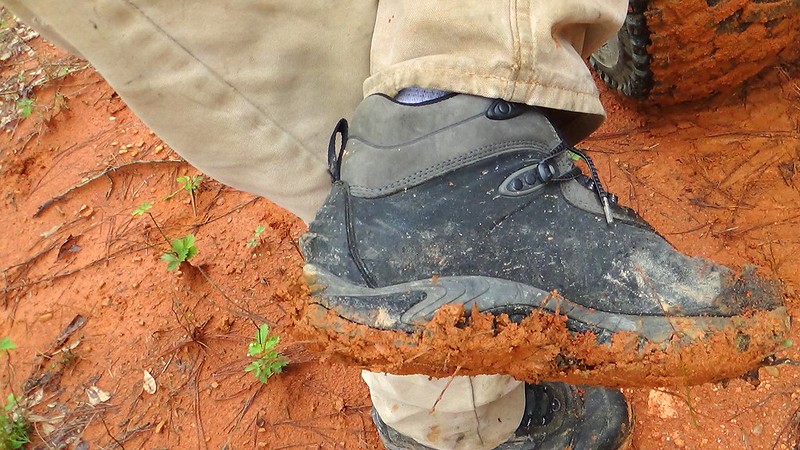 A mud ball made from yesterday's clay, semi damp and dropped from 4 feet 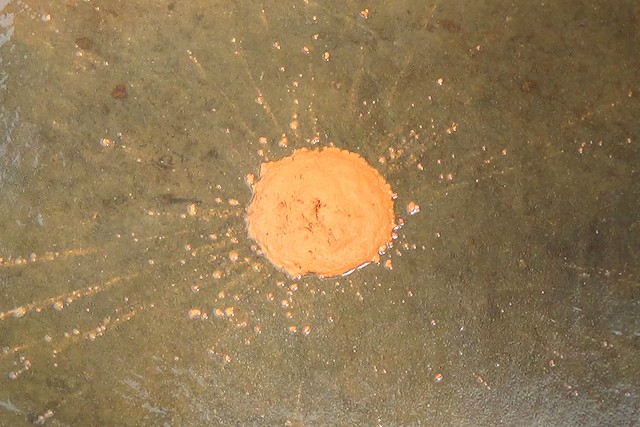 clay on left is higher in silica sand content, lighter in color 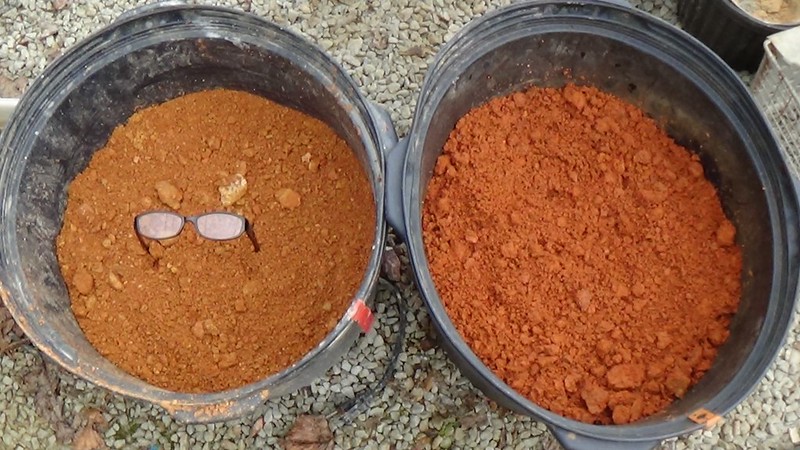 |
|
michaelr
off to a rocking start

Member since April 2015
Posts: 16 
|
Post by michaelr on Apr 20, 2015 9:35:53 GMT -5
is it possible to test for silica content before trying the clay in the polish stage? how would one do that anyway?? ... curious
|
|
jamesp
Cave Dweller 
Member since October 2012
Posts: 36,607
|
Post by jamesp on Apr 20, 2015 9:44:44 GMT -5
is it possible to test for silica content before trying the clay in the polish stage? how would one do that anyway?? ... curious That is a tuff one Michael. Hard to know when particles are small. However, clay does stay suspended and quartz sinks much faster. So separation process is possible, like nature's deposits of clay silt. Some huge ancient deposits are most likely sand free. But most clay operations desire quartz in them. Having a hard time finding quartz free clay in suppliers MSDS sheets. Go figure. Potters intentionally add sand. Clay slurry great for coarse grind, no concern about quartz in that stage. 220 stage either. It would take test equipment beyond most people's means to analyze such. |
|
michaelr
off to a rocking start

Member since April 2015
Posts: 16 
|
Post by michaelr on Apr 20, 2015 9:50:48 GMT -5
from other posts of yours re use of slurry, this week when i recharged my two 3lb barrels (rough grind), i used the rock 'paste' that was in the bottom of my rock tile saw from trimming rough... agate & jasper. it's only been a couple of days... we'll see how it goes..  |
|
|
|
Post by gingerkid on Apr 20, 2015 10:46:38 GMT -5
from other posts of yours re use of slurry, this week when i recharged my two 3lb barrels (rough grind), i used the rock 'paste' that was in the bottom of my rock tile saw from trimming rough ... agate & jasper. it's only been a couple of days... we'll see how it goes..  Interesting, and I hope you'll create a thread of using your tile saw 'paste' for grit experiment, michaelr. |
|
jamesp
Cave Dweller 
Member since October 2012
Posts: 36,607
|
Post by jamesp on Apr 20, 2015 11:28:13 GMT -5
When I use glass for filler I get a paste that concretes. So far the clay has not done that knock on wood. I tried pulverized lime and about had to get a jack hammer to break apart the concretion. Even after turning the rotary off for only 2 minutes. I think it was portland. please share the saw paste experience michaelrAfter 24 hours the clay has a sensuous texture; I think I am needing some psychological help here. |
|